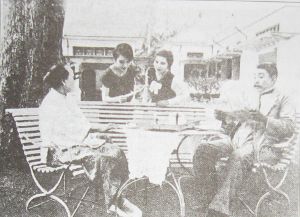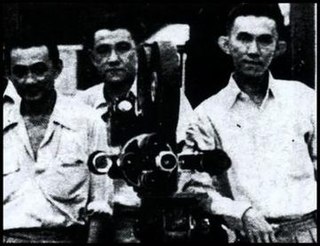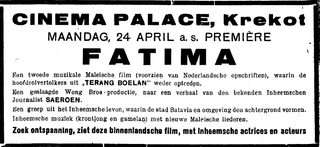
Lutung Kasarung is a Sundanese folktale from Indonesia. Set in the Pasir Batang Kingdom, it tells the tale of a magical lutung who helped a beautiful princess, Purbasari Ayuwangi, when her older sister attempted to rob her of her status as crown princess. The story is from an old Sundanese quatrain.

Eulis Atjih is a 1927 film from the Dutch East Indies ; it was the second feature film produced in the country, after Loetoeng Kasaroeng in 1926. The silent film follows the lives of a native Indonesian family sent into poverty by the husband's splurging. Eulis Atjih was a commercial success in the Indies, but failed in international markets.

Terang Boelan is a 1937 film from the Dutch East Indies. Written by Saeroen, directed by Albert Balink, and starring Rd Mochtar, Roekiah and Eddie T. Effendi, Terang Boelan follows two lovers who elope after one is almost forced to marry an opium smuggler. The film was shot in the Indies and Singapore, and was partially inspired by the 1936 Hollywood film The Jungle Princess. It was aimed at native audiences and included keroncong music, which was popular at the time, and several actors from Balink's previous work Pareh (1936).

George Eduard Albert Krugers was a cameraman and film director active in the Dutch East Indies during the early 20th century. He is recorded as having worked in film since the mid-1920s, and in 1927 he made his directorial debut, Eulis Atjih. He joined hajj pilgrims in 1928 and screened the resulting documentary in the Netherlands. His 1930 film Karnadi Anemer Bangkong is thought to be the first talkie in the cinema of the Indies, but was a commercial failure as the majority Sundanese audience considered it insulting. After making two works for Tan's Film in the early 1930s, Krugers moved to Hong Kong and then the Netherlands.

Lilly van Java, also known as Melatie van Java, is a 1928 film from the Dutch East Indies directed by Nelson Wong. Initially meant to be produced by South Sea Film and shot by an American director, the film – which follows a woman told to marry a man she does not love – was ultimately completed by Wong's Halimoen Film. Details on its cast and performance are contradictory, although the film is recognised as the first of a long series of ethnic Chinese-produced films in the country. It is likely a lost film.

The Wong brothers were three ethnic Chinese film directors and cameramen active in the cinema of the Dutch East Indies. The sons of an Adventist preacher, the brothers – Nelson (1895–1945), Joshua (1906–1981), and Othniel (1908–1986) – received much of their education in the United States before going to Shanghai and establishing The Great Wall Productions.
Karnadi Anemer Bangkong is a 1930 comedy from the Dutch East Indies directed by George Krugers. It is considered the country's first talkie, although parts were silent and the sound quality was poor. Based on a popular Sundanese novel, the film was considered controversial by the native audience.

Roekihati is a 1940 film from the Dutch East Indies. Directed by the brothers Joshua and Othniel Wong and produced by Tan's Film, it follows a young village woman who goes to the city and encounters various difficulties. Targeted at lower-class audiences, it was shot in black-and-white and starred Roekiah and Raden Djoemala.

Roestam Sutan Palindih was an Indonesian film director and writer. He was born in Fort de Kock, Dutch East Indies in 1898. He finished his education in various cities, including Batavia, Bandung, Padang, and Medan. In the 1920s and 30s Rustam held a variety of jobs, including as the owner of a small shop and a farmer. He eventually became involved with the journalistic and literary industries, working at Balai Pustaka and heading the newspaper Neratja. From 1933 until 1938 he was a member of a native political council, vocally opposing the Dutch colonial presence in the Indies.
Boenga Roos dari Tjikembang is a 1931 film from the Dutch East Indies directed, produced, and filmed by The Teng Chun. Based on a 1927 novel of the same name, it follows the complicated romantic situations of two generations of ethnic Chinese in the Indies. An early example of domestic sound films, the film was remade in 1975.

Siti Akbari is a 1940 film from the Dutch East Indies directed by Joshua and Othniel Wong and produced by Tan Khoen Yauw. Starring Roekiah and Rd Mochtar, it follows a couple while the husband commits adultery.

Indonesia Malaise is a 1931 film directed by the Wong brothers. It was the brothers' first sound film and one of the first such films in the Dutch East Indies. Billed as a comedy, the story follows a woman who is overcome by tragedy in her personal life. A commercial failure, it may be lost.

Darah dan Doa is a 1950 Indonesian war film directed and produced by Usmar Ismail, telling the story of the Siliwangi Division and its leader Captain Sudarto on a march to West Java. Following Ismail's Dutch-produced Tjitra (1949), Darah dan Doa is often cited as the first 'Indonesian' film, and the film's first day of shooting – 30 March – is celebrated in Indonesia as National Film Day.

Fatima is a 1938 film from the Dutch East Indies directed by Othniel and Joshua Wong. Written by Saeroen, it starred Roekiah, Rd Mochtar, and ET Effendi and followed two lovers who are disturbed by a rich youth. The film followed the same formula as the earlier hit Terang Boelan, and saw commercial success domestically. It is one of three films which Misbach Yusa Biran credits with reviving the domestic film industry, which had been faltering.
Si Tjonat is a likely lost 1929 bandit film from the Dutch East Indies directed by Nelson Wong and produced by Wong and Jo Eng Sek. Based on the novel by F.D.J. Pangemanann, the silent film followed an indigenous man who, having killed his fellow villager, flees to Batavia and becomes a bandit. After kidnapping an ethnic Chinese woman, he is defeated and brought to justice.
Elang Darat is a 1941 film from the Dutch East Indies which was directed by Inoe Perbatasari and produced by The Teng Chun for Jacatra Film. A detective film, it follows a man who comes to a village to track the villainous bandit known only as "Elang Darat".
Njai Dasima is a 1932 film from the Dutch East Indies which was directed by Bachtiar Effendi for Tan's Film. It was the second film adapted from G. Francis' 1896 novel Tjerita Njai Dasima, following a silent version in 1929. Starring Momo and Oesman, it followed a young Sundanese njai (concubine) who is tricked into marrying a man who does not love her and ultimately killed for her money. The film, the first talkie produced by its company, was also the first directed by a native Indonesian. The now-lost work received mixed critical reception.













